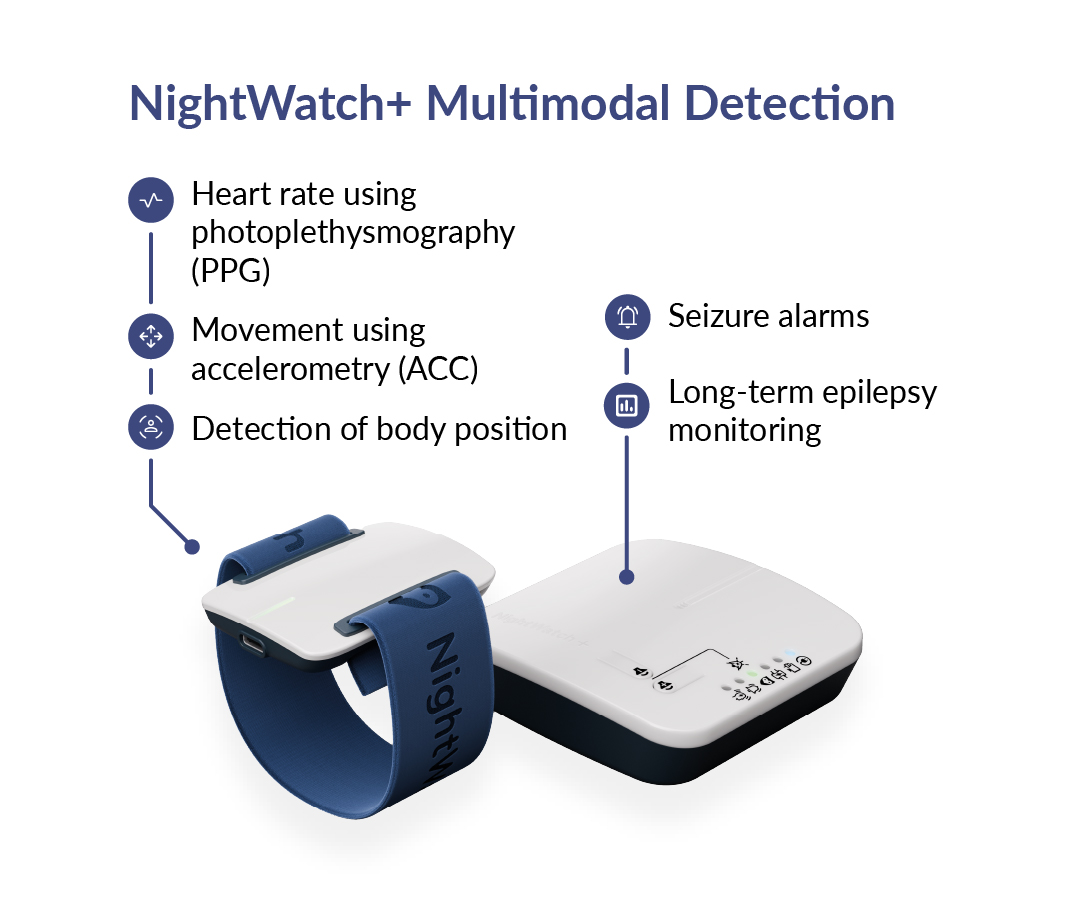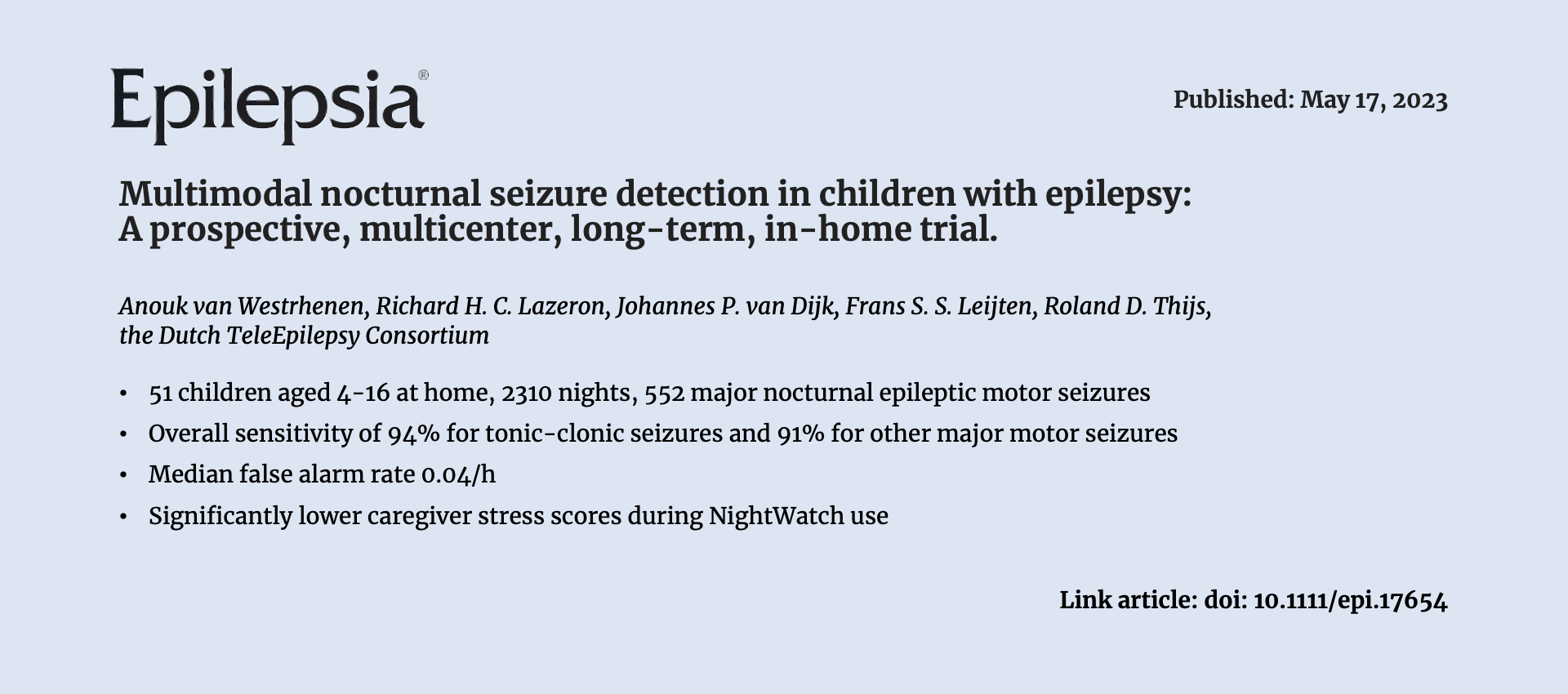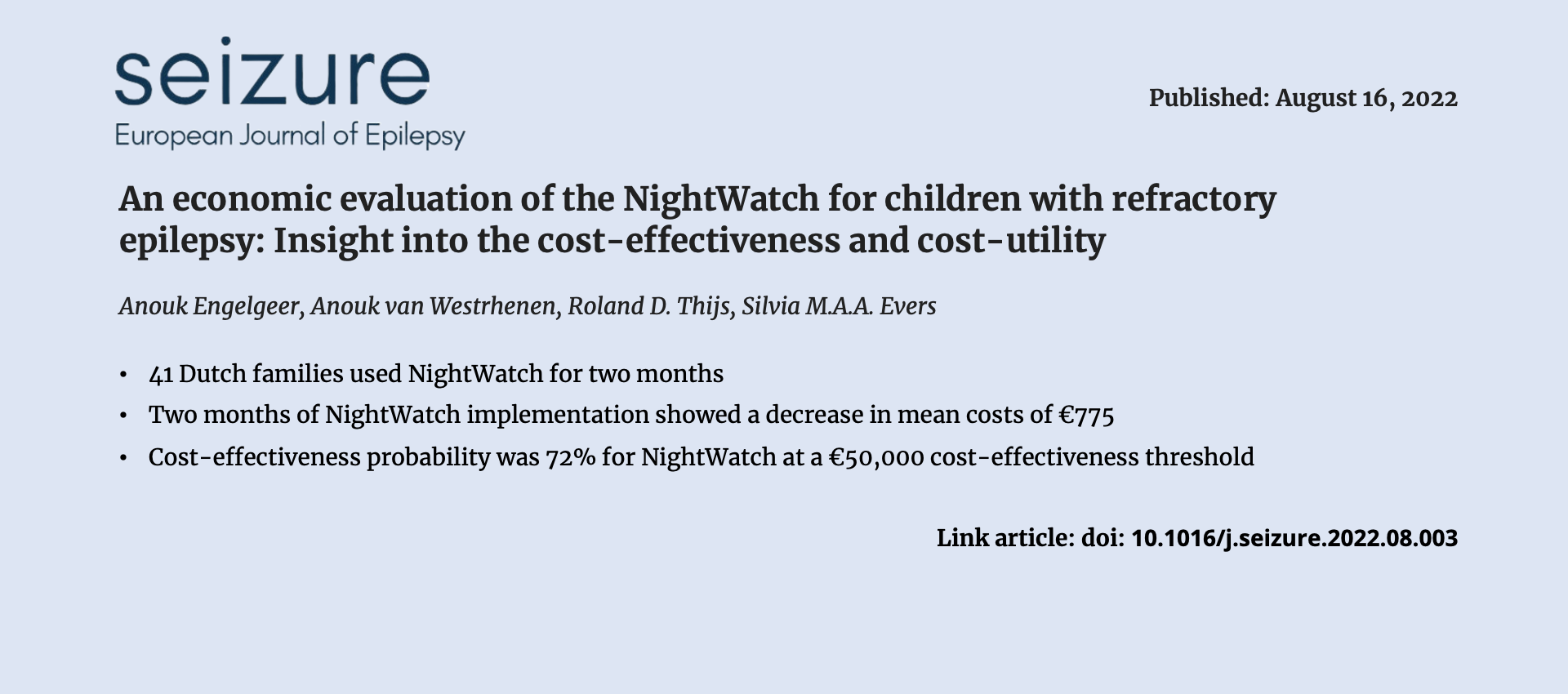Studi scientifici
Ricerca
NightWatch+ è il risultato di decenni di ricerca congiunta del consorzio olandese TeleEpilepsy.
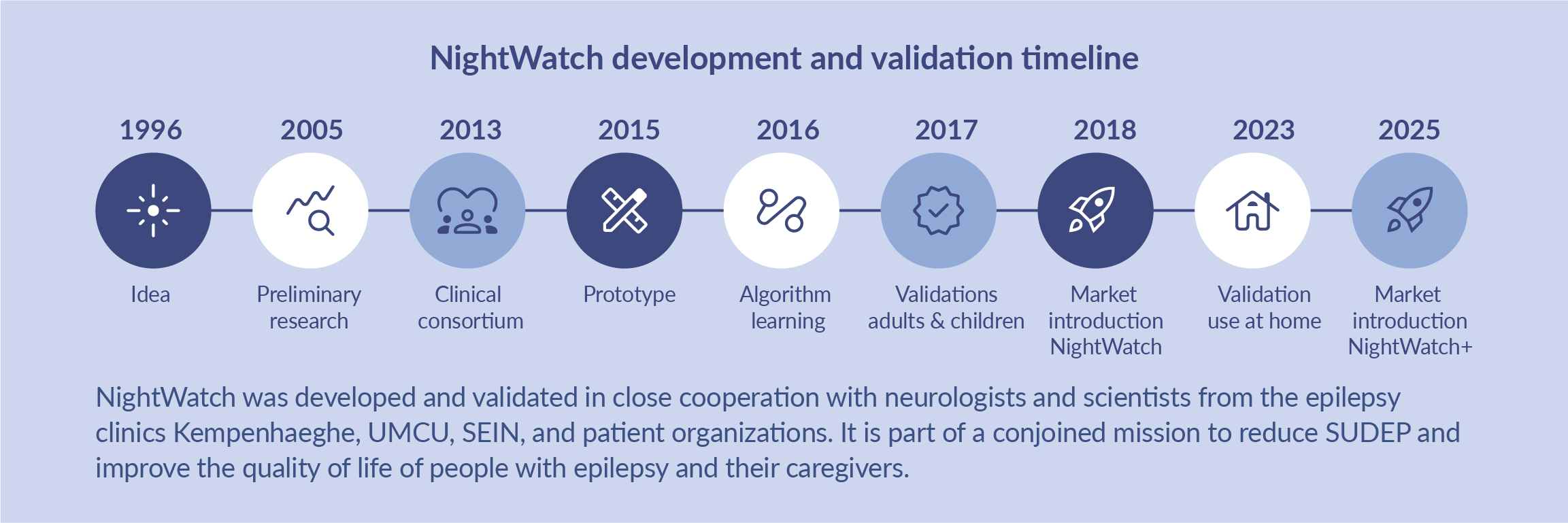
- Crisi tonico-cloniche
- Crisi toniche (raggruppate o prolungate)
- Crisi ipercinetiche
- Crisi miocloniche (raggruppate)
Efficace rilevamento delle crisi epilettiche
NightWatch rileva le crisi epilettiche motorie notturne monitorando le variazioni della frequenza cardiaca e gli schemi di movimento specifici attraverso un sensore indossabile. Si avvale di una tecnologia PPG avanzata per il rilevamento della frequenza cardiaca e di un accelerometro 3D per la posizione e il movimento del corpo. L’algoritmo di rilevamento è stato ottimizzato sulla base di dati a lungo termine di adulti e bambini (> 4 anni di età) con migliaia di crisi epilettiche notturne, convalidati rispetto alle registrazioni video come standard di riferimento.
Prestazioni di rilevamento convalidate
Le prestazioni di rilevamento di NightWatch sono state convalidate attraverso molteplici studi multicentrici in ambienti domestici realistici, impiegando l’annotazione video come standard di riferimento e condotti da infermieri addestrati. Questo modello di studio ha consentito la valutazione per periodi prolungati in cui un EEG continuo non era fattibile. Per ridurre al minimo le imprecisioni dovute a crisi non rilevate, i caregiver hanno documentato le crisi osservate, mentre gli strumenti automatizzati come i sensori del letto e l’analisi video hanno supportato il rilevamento, con gli infermieri coinvolti nello studio che hanno controllato a caso il 5%-10% delle registrazioni per un’ulteriore verifica.
Gli studi hanno dimostrato una sensibilità mediana dell’86% per gli adulti e del 100% per i bambini per tutti i principali tipi di crisi motorie, del 96% per gli adulti e del 100% per i bambini (> 4 anni di età) per le crisi tonico-cloniche. Il tasso medio di falsi allarmi è stato di circa 0,04 all’ora. I tassi di falsi allarmi variavano fortemente tra gli utenti e molti falsi allarmi erano in realtà crisi minori non qualificabili come crisi motorie notturne.
Altre pubblicazioni rilevanti su NightWatch o sui suoi principi operativi
- Zelano, J., Beniczky, S., Ryvlin, P., Surges, R., Tomson, T., & the ILAE SUDEP Task Force. (2023). Report of the ILAE SUDEP Task Force on national recommendations and practices around the world regarding the use of wearable seizure detection devices: A global survey. Epilepsia Open. doi.org/10.1002/epi4.12801
Summary:
The article “Report of the ILAE SUDEP Task Force on national recommendations and practices around the world regarding the use of wearable seizure detection devices” examines global recommendations and practices concerning the use of wearable devices for seizure detection. It highlights the importance of these technologies in monitoring seizures and their potential to enhance patient safety. The article mentions that NightWatch has been clinically tested in the Netherlands and is used in epilepsy care. The device has contributed to increased patient safety and improved nighttime monitoring. - Hadady L, Klivényi P, Fabó D, Beniczky S. Real-world user experience with seizure detection wearable devices in the home environment. Epilepsia. 2022;00:1–6. doi: 10.1111/epi.17189
Summary:
The article examines the practical usability and effectiveness of wearable seizure detection devices in a home setting. It highlights the general feasibility and benefits of automated seizure detection at home, which can contribute to improved monitoring and safety for patients with epilepsy. - van Elmpt WJC, Nijsen TME, Griep PAM, Arends JBAM. A model of heart rate changes to detect seizures in severe epilepsy. Seizure. 2006;15(6):366–75. doi: 10.1016/j.seizure.2006.03.005
Summary:
The article explores using heart rate changes to detect seizures in patients with severe epilepsy. It developed two algorithms to monitor heart rate patterns, identifying significant changes like tachycardia and bradycardia during seizures. The study found that heart rate changes occurred in most patients. It concluded that heart rate changes can be used for automatic seizure detection, provided the model parameters are tailored to individual patients. - Massé F, Penders J, Serteyn A, van Bussel M, Arends J. Miniaturized wireless ECG-monitor for real-time detection of epileptic seizures. WH’10. 2010 Oct; 111-117. doi: 10.1145/1921081.1921095
Summary:
The article highlights the feasibility of using heart rate changes as indicators for seizure activity, offering a non-invasive method for monitoring patients with epilepsy. - Lamberts RJ, Thijs RD, Laffan A, Langan Y, Sander JW. Sudden unexpected death in epilepsy: People with nocturnal seizures may be at highest risk: Nocturnal Seizures as a Risk for SUDEP. Epilepsia. 2012;53(2):253–7. doi: 10.1111/j.1528-1167.2011.03360.x
Summary:
The article investigates the association between nocturnal seizures and the risk of sudden unexpected death in epilepsy (SUDEP). The study suggests that individuals experiencing seizures during sleep may have an increased risk of SUDEP. These findings underscore the importance of preventive measures, which may include nighttime monitoring and interventions to reduce seizure frequency during sleep. - van Andel J, Leijten F, van Delden H, van Thiel G (2015) What Makes a Good Home-Based Nocturnal Seizure Detector? A Value Sensitive Design. PLoS ONE 10(4): e0121446. doi: 10.1371/journal.pone.0121446
Summary:
The study investigates the development of a device for in-home detection of nocturnal seizures in patients with severe epilepsy. It identifies five key values: health, trust, autonomy, accessibility, and reliability. These values were then linked to design choices for the device. - Arends JB, van Dorp J, van Hoek D, Kramer N, van Mierlo P, van der Vorst D, et al. Diagnostic accuracy of audio-based seizure detection in patients with severe epilepsy and an intellectual disability. Epilepsy Behav. 2016;62:180–5. doi: 10.1016/j.yebeh.2016.06.008
Summary:
The study evaluates the use of audio monitoring for detecting major seizures in patients with severe epilepsy. It suggests that audio-based detection could be used alone or in combination with other systems for better seizure monitoring. - van Andel J, Thijs RD, de Weerd A, Arends J, Leijten F. Non-EEG based ambulatory seizure detection designed for home use: What is available and how will it influence epilepsy care? Epilepsy Behav. 2016;57:82–9. doi: 10.1016/j.yebeh.2016.01.003
Summary:
The article reviews existing non-EEG seizure detection systems suitable for home use. It evaluates various devices and algorithms, discussing their potential impact on epilepsy management. The study emphasizes the importance of these technologies in enhancing patient safety and monitoring outside clinical settings. - van der Lende M, Cox FME, Visser GH, Sander JW, Thijs RD. Value of video monitoring for nocturnal seizure detection in a residential setting. Epilepsia. 2016;57(11):1748–53. doi: 10.1111/epi.13558
Summary:
Conducted in a residential care facility, the research found that video Monitoring significantly increased the identification of seizures requiring clinical intervention. The study concluded that Video monitoring is a valuable tool for enhancing patient safety and improving the management of nocturnal seizures in such settings. - van Andel J, Ungureanu C, Arends J, Tan F, Van Dijk J, Petkov G, et al. Multimodal, automated detection of nocturnal motor seizures at home: Is a reliable seizure detector feasible? Epilepsia Open. 2017;2(4):424–31. doi: 10.1002/epi4.12076
Summary:
The study investigates the feasibility of using non-electroencephalographic (non-EEG) signals—specifically heart rate and accelerometry—to detect various types of nocturnal seizures, including tonic, tonic-clonic, hypermotor, and clusters of short myoclonic/tonic seizures. The research involved monitoring patients during diagnostic video-EEG examinations. The findings suggest that automated seizure detection using these non-EEG signals is feasible and could enhance patient safety by enabling timely interventions. - Geertsema EE, Thijs RD, Gutter T, Vledder B, Arends JB, Leijten FS, et al. Automated video-based detection of nocturnal convulsive seizures in a residential care setting. Epilepsia. 2018;59:53–60. doi: 10.1111/epi.14050
Summary:
The study evaluates the effectiveness of a video-based algorithm for detecting nocturnal convulsive seizures in individuals with epilepsy residing in a care facility. The algorithm analyzes group velocity signals derived from video sequences to identify seizures. The study concludes that this automated system is effective for real-time seizure detection in residential care settings, potentially enhancing patient safety.
NightWatch per gli studi clinici
Migliorate i vostri studi clinici con dati sul sonno di alta qualità e a lungo termine, raccolti con un disturbo minimo per i pazienti. NightWatch consente di ottenere parametri chiave quali PPG, dati sul movimento e frequenza delle crisi nel tempo, supportando diverse esigenze di ricerca:
- Portale dei dati di NightWatch
- API dei dati di NightWatch
- Kit di ricerca di NightWatch
Portale dei dati di NightWatch
La piattaforma di monitoraggio dei dati online consente agli utenti di annotare le crisi, aggiungere informazioni e accedere a dati dettagliati sulla FC e sui movimenti registrati durante il sonno. Disponibile per tutti gli utenti NightWatch standard, offre un modo semplice e intuitivo per monitorare i dati delle crisi nel tempo.
API di NightWatch
L’API dei dati di NightWatch consente l’integrazione con piattaforme di ricerca di terzi o diari digitali delle crisi epilettiche, permettendo di registrare in tempo reale gli allarmi delle crisi notturne, i dati sulla frequenza cardiaca e i modelli di movimento durante il sonno.
Kit di ricerca di NightWatch
Il kit di ricerca plug-and-play è progettato per l’uso domestico o istituzionale in progetti clinici e di ricerca. Consente la raccolta oggettiva e a lungo termine di dati sulle crisi notturne, tra cui:
- Allarmi di crisi epilettiche: Allarmi di crisi epilettiche con data e ora per:
– Crisi tonico-cloniche
– Crisi toniche (raggruppate o prolungate)
– Crisi ipercinetiche
– Crisi miocloniche (raggruppate) - Dati PPG grezzi: tracciamento della frequenza cardiaca battito per battito
- Dati dell’accelerometro XYZ: tracciamento del movimento
- Dati sulla posizione del corso
- Monitoraggio video: Telecamera a infrarossi di alta qualità con registrazione video e audio continua, che consente l’annotazione clinica delle crisi avvalendosi di video come punto di riferimento.
Caratteristiche del kit
Il kit di ricerca di NightWatch è contenuto in una scatola portatile con serratura e ruote e comprende:
- Dispositivo NightWatch
- PC integrato con disco rigido esterno
- Router 4G per l’accesso remoto
- Connessioni multiple esterne a relè o LAN per dispositivi aggiuntivi
- Telecamera a infrarossi per la visione notturna
- Sistema di raffreddamento attivo
Tutti i dati vengono memorizzati localmente e, se necessario, possono essere consultati in remoto tramite LAN o 4G.
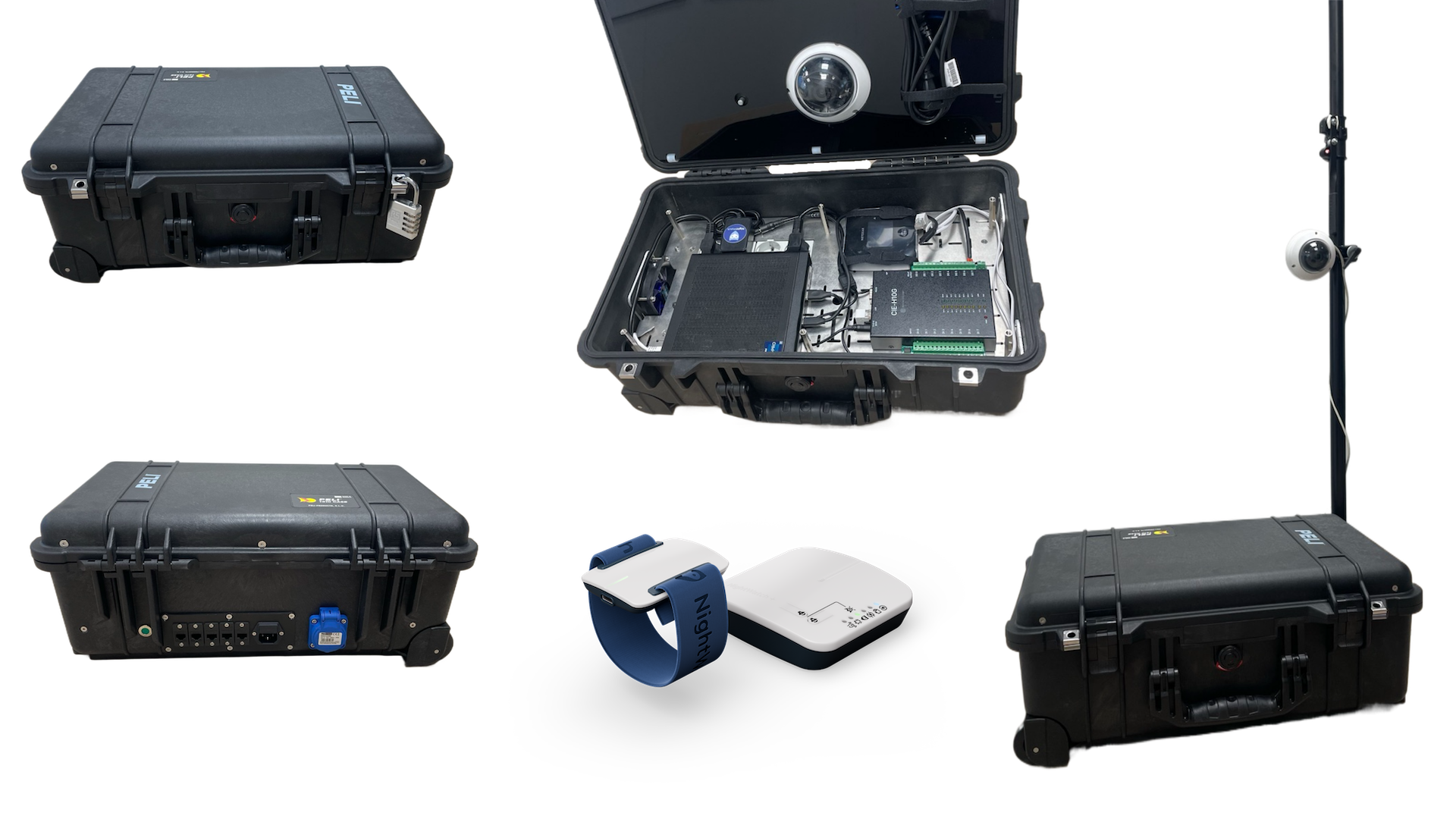
Contatti:
Per maggiori informazioni su disponibilità e prezzi, invia un’e-mail a info@nightwatchepilepsy.com
Letteratura citata
- Arends J, Thijs RD, Gutter T, Ungureanu C, Cluitmans P, van Dijk J, et al. Multimodal nocturnal seizure detection in a residential care setting: A long-term prospective trial, Neurology. 2018 Nov 20; 91(21):e2010-e2019. doi: 10.1212/WNL.0000000000006545
- Beniczky S, Wiebe S, Jeppesen J, Tatum WO, Brazdil M, Wang Y, et al. Automated seizure detection using wearable devices: A clinical practice guideline of the International League Against Epilepsy and the International Federation of Clinical Neurophysiology. Epilepsia. 2021 Mar; 62(3):632-646. doi: 10.1016/j.clinph.2020.12.009.
- Lazeron RHC, Thijs RD, Arends J, Gutter T, Cluitmans P, van Dijk J, et al. Multimodal nocturnal seizure detection: Do we need to adapt algorithms for children? Epilepsia. 2022; 7(3):406–13. doi: 10.1002/epi4.12618
- van Westrhenen A, Lazeron RHC, van Dijk JP, Leijten FSS, Thijs RD, the Dutch TeleEpilepsy Consortium. Multimodal nocturnal seizure detection in children with epilepsy: A prospective, multicenter, long‐term, in‐home trial. Epilepsia. 2023. doi: 10.1111/epi.17654
- Engelgeer A, van Westrhenen A, Thijs RD, Evers SMAA. An economic evaluation of the NightWatch for children with refractory epilepsy: Insight into the cost-effectiveness and cost-utility. Seizure. 2022;101:156–61. doi: 10.1016/j.seizure.2022.08.003
